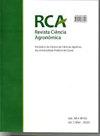The use of numerical modelling to assess soil water dynamics in subsurface irrigation
IF 0.7
4区 农林科学
Q3 AGRICULTURE, MULTIDISCIPLINARY
引用次数: 1
Abstract
- Knowledge of soil water dynamics is essential for establishing appropriate methods of irrigation management. Water dynamics in unsaturated soils is a complex process that can be explained by the Richards equation. As this is a non-linear differential equation, there is no analytical solution, but requires the use of the fi nite element method, for example, to obtain solutions, where simulations using numerical modelling make it p ossible to predict the the fl ow of water from the soil. As such, the aim of this study was to evaluate a 2D numerical model in simulating wate r distribution and wet bulb formation resulting from a subsurface irrigation system, in addition to validating the generated model. The Pearson correlation coef fi cient (r), the coef fi cient of deter mination (R 2 ) and the root-mean-square error (RMSE) were calculated. For each treatment, both during and after irrigation, the model showed a small relative error, high values for R 2 and a positive correlation with the fi eld data. It was concluded that the model is applicable to the design and management of subsurface irrigation systems, varying the installation depth of the drip tube, the spacing between emitters and the soil moisture, giving good results for the various simulated scenarios.利用数值模拟评估地下灌溉中土壤水分动态
-土壤水动力学知识对建立适当的灌溉管理方法至关重要。非饱和土中的水动力学是一个复杂的过程,可以用理查兹方程来解释。由于这是一个非线性微分方程,没有解析解,而是需要使用有限元方法,例如,来获得解,其中使用数值模拟的模拟使得预测土壤中的水流成为可能。因此,除了验证生成的模型外,本研究的目的是评估模拟地下灌溉系统产生的水分布和湿球体形成的二维数值模型。计算Pearson相关系数(r)、决定系数(r2)和均方根误差(RMSE)。对于灌溉期间和灌溉后的每个处理,模型的相对误差较小,r2值较高,与田间数据呈正相关。结果表明,该模型适用于地下灌溉系统的设计和管理,可以改变滴管的安装深度、发射器间距和土壤湿度,对各种模拟场景都有较好的模拟效果。
本文章由计算机程序翻译,如有差异,请以英文原文为准。
求助全文
约1分钟内获得全文
求助全文
来源期刊

Revista Ciencia Agronomica
Agricultural and Biological Sciences-Horticulture
CiteScore
2.00
自引率
0.00%
发文量
41
审稿时长
4-8 weeks
期刊介绍:
To publish technical-scientific articles and study cases (original projects) that are not submitted to other journals, involving new researches and technologies in fields related to Agrarian Sciences. Articles concerning routine analysis, preliminary studies, technical notes and those which merely report laboratorial analysis employing traditional methodology will not be accepted for publication. The Journal of Agronomical Science also has the mission to promote the exchange of experience in the referred fields.
 求助内容:
求助内容: 应助结果提醒方式:
应助结果提醒方式:


